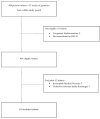Neonatal Sequential Organ Failure Assessment (nSOFA) Score within 72 Hours after Birth Reliably Predicts Mortality and Serious Morbidity in Very Preterm Infants
- PMID: 35741152
- PMCID: PMC9221565
- DOI: 10.3390/diagnostics12061342
Neonatal Sequential Organ Failure Assessment (nSOFA) Score within 72 Hours after Birth Reliably Predicts Mortality and Serious Morbidity in Very Preterm Infants
Abstract
The aim of this study was to assess the applicability of the neonatal sequential organ failure assessment score (nSOFA) within 72 h after delivery as a predictor for mortality and adverse outcome in very preterm neonates. Inborn neonates <32 weeks of gestation were evaluated. The nSOFA scores were calculated from medical records in the first 72 h after birth and the peak value was used for analysis. Death or composite morbidity at hospital discharge defined the adverse outcome. Composite morbidity consisted of chronic lung disease, intraventricular haemorrhage ≥grade III, periventricular leukomalacia and necrotizing enterocolitis. Among 423 enrolled infants (median birth weight 1070 g, median gestational age 29 weeks), 27 died and 91 developed composite morbidity. Death or composite morbidity was associated with organ dysfunction as assessed by nSOFA, systemic inflammatory response, and low birthweight. The score >2 was associated with OR 2.5 (CI 1.39−4.64, p = 0.002) for the adverse outcome. Area under the curve of ROC was 0.795 (95% CI = 0.763−0.827). The use of nSOFA seems to be reasonable for predicting mortality and morbidity in very preterm infants. It constitutes a suitable basis to measure the severity of organ dysfunction regardless of the cause.
Keywords: neonatal intensive care; organ dysfunction score; preterm birth.
Conflict of interest statement
All authors have no conflict of interest to disclose.
Figures



References
-
- Jaskari J., Myllarinen J., Leskinen M., Rad A.B., Hollmen J., Andersson S., Sarkka S. Machine Learning Methods for Neonatal Mortality and Morbidity Classification. IEEE Access. 2020;8:123347–123358. doi: 10.1109/ACCESS.2020.3006710. - DOI
Grants and funding
LinkOut - more resources
Full Text Sources

